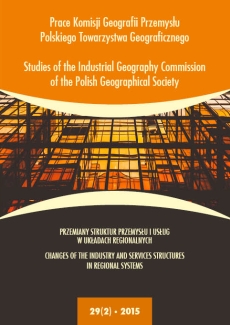Selected Aspects of the Structural Changes and the Innovativeness of Silesian Industry – a Spatial Perspective
DOI:
https://doi.org/10.24917/20801653.292.9Keywords:
innovative activity, structural changes, industry, Silesian region, spatial differentiationAbstract
Structural changes and production innovation lead to an increase in labour productivity and have a positive impact on the economic growth of country and its regions. The aim of the study is to present selected issues relating to changes in the structure and the level of innovativeness in Silesia, highly industrialized region in south western Poland (the region covers three voivodeships: Lower Silesian, Opole and Silesian). Furthermore, assess the degree of spatial changes of industry in the whole analyzed area in the period 2005-2012 has been done. The scope of the analysis depends on the availability of data on local level. The article presents an analysis on the changes of the spatial differentiation of selected indicators in Silesia, like working in industry, production, value of industrial output, gross value added. Analysis of innovative activities in voivodeships (= provinces) in Poland and in the poviats (= counties) of Silesian region was based on four indicators, which characterize innovation activity, expenditure on it, its effectiveness as revenues from the production of new or substantially improved products and the level of fitting with the means of manufacturing automation. These parameters were used to construct a synthetic indicator of structural changes and innovation that illustrates the intra-regional competitiveness of the poviats. Analysis of structural changes and innovation of the industry of Silesia is presented in relation to other voivodeships what allows to determine the position of the region to the rest of the country.
Downloads
Metrics
References
Bank Danych Lokalnych (2014, 15 listopada). Pozyskano z http://www.stat.gov.pl/bdl/app/strona.html?p_name=indeks.
Brezdeń, P., Górecka, S., Tomczak, P. (2012). Edukacja i rynek pracy Dolnego Śląska na tle uwarunkowań demograficznych. Rozprawy Naukowe Instytutu Geografii i Rozwoju Regionalnego, 22. Wrocław: Uniwersytet Wrocławski.
Brezdeń P., Spallek, W. (2009). Efektywność firm korporacyjnych o dobrym standingu w województwie dolnośląskim w ujęciu przestrzennym. Prace Komisji Geografii Przemysłu Polskiego Towarzystwa Geograficznego, 14, 81–94.
Brezdeń, P., Spallek, W. (2013). Przestrzenne zróżnicowanie poziomu innowacyjności regionalnej gospodarki województwa dolnośląskiego. Prace Komisji Geografii Przemysłu Polskiego Towarzystwa Geograficznego, 23, 9–25.
Dane statystyczne z badania PNT-02 dla województwa śląskiego i opolskiego według powiatów (2012).Szczecin: Urząd Statystyczny w Szczecinie.
Diagnoza pogłębiona innowacyjności gospodarki Małopolski. Opracowanie przygotowane na potrzeby prac nad Regionalną Strategią Innowacji Województwa Małopolskiego na lata 2013–2020 (2012). Kraków: Urząd Marszałkowski Województwa Małopolskiego.
Działalność innowacyjna przedsiębiorstw w latach 2010–2012 (2013). Szczecin: Urząd Statystyczny w Szczecinie.
Gomułka, S. (1998). Teoria innowacji i wzrostu gospodarczego. Warszawa: Centrum Analiz Społeczno - Ekonomicznych.
Identyfikacja i delimitacja obszarów wzrostu i obszarów problemowych w województwie dolnośląskim (2012). Cz. 2. Studia nad rozwojem Dolnego Śląska, 2(51). Wrocław: Urząd Marszałkowski Województwa Dolnośląskiego.
Innovation Union Scoreboard 2012. Enterprise and Industry (2013, 14 listopada). Pozyskano z http:// ec.europa.eu/enterprise/policies/innovation/files/ius-2013_en.pdf.
Innovation Union Scoreboard 2013. The Innovation Union’s performance scoreboard for Research and Innovation (2014, 12 listopada). Pozyskano z http://ec.europa.eu/enterprise/policies/innovation/files/ius/ius-2014_en.pdf.
Klamut, M. (1996). Ewolucja struktury gospodarczej w krajach wysoko rozwiniętych, Wrocław:Uniwersytet Ekonomiczny we Wrocławiu.
Nauka i technika w 2012 r. Science and technology in Poland in 2012 (2013). Szczecin: UrządStatystyczny w Szczecinie.
Nowak, E. (1990). Metody taksonomiczne w klasyfikacji obiektów społeczno-ekonomicznych. Warszawa: Polskie Wydawnictwo Ekonomiczne.
Nowicki, M. (red.) (2013). Atrakcyjność inwestycyjna województw i podregionów Polski 2013. Gdańsk:Instytut Badań nad Gospodarką Rynkową.
Podręcznik Oslo. Zasady gromadzenia i interpretacji danych dotyczących innowacji (2008). Warszawa:OECD, Eurostat, Ministerstwo Nauki i Szkolnictwa Wyższego.
Śleszyński, P. (2009). Zmiany strukturalne i przestrzenno-funkcjonalne w rozwoju przedsiębiorczości po przystąpieniu Polski do Unii Europejskiej, Studia Regionalne i Lokalne, 3(37), 5–26.
Winiarski, B. (2002). Polityka gospodarcza. Warszawa: Wydawnictwo Naukowe PWN.
Downloads
Published
How to Cite
Issue
Section
License
Articles are published under the terms of the Creative Commons License (CC BY-ND 4.0; Attribution– NoDerivs).

